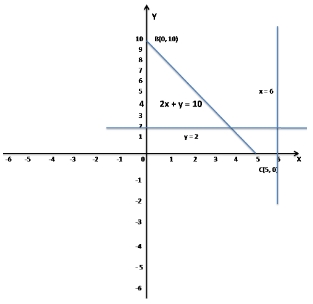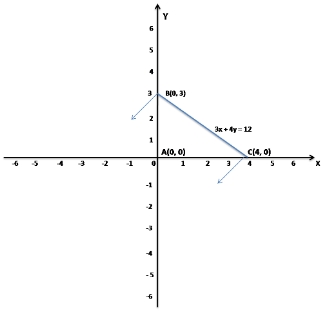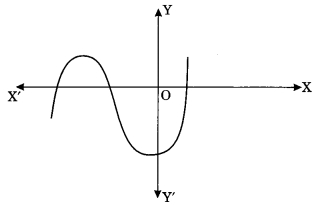Check the below NCERT MCQ Questions for Class 11 Maths Chapter 9 Sequences and Series with Answers Pdf free download. MCQ Questions for Class 11 Maths with Answers were prepared based on the latest exam pattern. We have provided Sequences and Series Class 11 Maths MCQs Questions with Answers to help students understand the concept very well. https://mcqquestions.guru/mcq-questions-for-class-11-maths-chapter-9/
Sequences and Series Class 11 MCQs Questions with Answers
Sequence And Series Class 11 MCQ Question 1.
If a, b, c are in G.P., then the equations ax² + 2bx + c = 0 and dx² + 2ex + f = 0 have a common root if d/a, e/b, f/c are in
(a) AP
(b) GP
(c) HP
(d) none of these
Answer
Answer: (a) AP
Hint:
Given a, b, c are in GP
⇒ b² = ac
⇒ b² – ac = 0
So, ax² + 2bx + c = 0 have equal roots.
Now D = 4b² – 4ac
and the root is -2b/2a = -b/a
So -b/a is the common root.
Now,
dx² + 2ex + f = 0
⇒ d(-b/a)² + 2e×(-b/a) + f = 0
⇒ db2 /a² – 2be/a + f = 0
⇒ d×ac /a² – 2be/a + f = 0
⇒ dc/a – 2be/a + f = 0
⇒ d/a – 2be/ac + f/c = 0
⇒ d/a + f/c = 2be/ac
⇒ d/a + f/c = 2be/b²
⇒ d/a + f/c = 2e/b
⇒ d/a, e/b, f/c are in AP
MCQ On Sequence And Series Class 11 Question 2.
If a, b, c are in AP then
(a) b = a + c
(b) 2b = a + c
(c) b² = a + c
(d) 2b² = a + c
Answer
Answer: (b) 2b = a + c
Hint:
Given, a, b, c are in AP
⇒ b – a = c – b
⇒ b + b = a + c
⇒ 2b = a + c
MCQ Of Sequence And Series Class 11 Question 3:
Three numbers form an increasing GP. If the middle term is doubled, then the new numbers are in Ap. The common ratio of GP is
(a) 2 + √3
(b) 2 – √3
(c) 2 ± √3
(d) None of these
Answer
Answer: (a) 2 + √3
Hint:
Let the three numbers be a/r, a, ar
Since the numbers form an increasing GP, So r > 1
Now, it is given that a/r, 2a, ar are in AP
⇒ 4a = a/r + ar
⇒ r² – 4r + 1 = 0
⇒ r = 2 ± √3
⇒ r = 2 + √3 {Since r > 1}
Class 11 Sequence And Series MCQ Question 4:
The sum of n terms of the series (1/1.2) + (1/2.3) + (1/3.4) + …… is
(a) n/(n+1)
(b) 1/(n+1)
(c) 1/n
(d) None of these
Answer
Answer: (a) n/(n+1)
Hint:
Given series is:
S = (1/1·2) + (1/2·3) + (1/3·4) – ………………. 1/n.(n+1)
⇒ S = (1 – 1/2) + (1/2 – 1/3) + (1/3 – 1.4) -……… (1/n – 1/(n+1))
⇒ S = 1 – 1/2 + 1/2 – 1/3 + 1/3 – 1/4 – ……….. 1/n – 1/(n+1)
⇒ S = 1 – 1/(n+1)
⇒ S = (n + 1 – 1)/(n+1)
⇒ S = n/(n+1)
Class 11 Maths Chapter 9 MCQ Question 5:
If 1/(b + c), 1/(c + a), 1/(a + b) are in AP then
(a) a, b, c are in AP
(b) a², b², c² are in AP
(c) 1/1, 1/b, 1/c are in AP
(d) None of these
Answer
Answer: (b) a², b², c² are in AP
Hint:
Given, 1/(b + c), 1/(c + a), 1/(a + b)
⇒ 2/(c + a) = 1/(b + c) + 1/(a + b)
⇒ 2b² = a² + c²
⇒ a², b², c² are in AP
Sequence And Series Class 11 MCQ Questions Question 6:
The sum of series 1/2! + 1/4! + 1/6! + ….. is
(a) e² – 1 / 2
(b) (e – 1)² /2 e
(c) e² – 1 / 2 e
(d) e² – 2 / e
Answer
Answer: (b) (e – 1)² /2 e
Hint:
We know that,
ex = 1 + x/1! + x² /2! + x³ /3! + x4 /4! + ………..
Now,
e1 = 1 + 1/1! + 1/2! + 1/3! + 1/4! + ………..
e-1 = 1 – 1/1! + 1/2! – 1/3! + 1/4! + ………..
e1 + e-1 = 2(1 + 1/2! + 1/4! + ………..)
⇒ e + 1/e = 2(1 + 1/2! + 1/4! + ………..)
⇒ (e² + 1)/e = 2(1 + 1/2! + 1/4! + ………..)
⇒ (e² + 1)/2e = 1 + 1/2! + 1/4! + ………..
⇒ (e² + 1)/2e – 1 = 1/2! + 1/4! + ………..
⇒ (e² + 1 – 2e)/2e = 1/2! + 1/4! + ………..
⇒ (e – 1)² /2e = 1/2! + 1/4! + ………..
MCQ Questions On Sequence And Series Class 11 Question 7:
The third term of a geometric progression is 4. The product of the first five terms is
(a) 43
(b) 45
(c) 44
(d) none of these
Answer
Answer: (b) 45
Hint:
here it is given that T3 = 4.
⇒ ar² = 4
Now product of first five terms = a.ar.ar².ar³.ar4
= a5r10
= (ar2)5
= 45
Class 11 Maths Ch 9 MCQ Question 8:
Let Tr be the r th term of an A.P., for r = 1, 2, 3, … If for some positive integers m, n, we have Tm = 1/n and Tn = 1/m, then Tm n equals
(a) 1/m n
(b) 1/m + 1/n
(c) 1
(d) 0
Answer
Answer: (c) 1
Hint:
Let first term is a and the common difference is d of the AP
Now, Tm = 1/n
⇒ a + (m-1)d = 1/n ………… 1
and Tn = 1/m
⇒ a + (n-1)d = 1/m ………. 2
From equation 2 – 1, we get
(m-1)d – (n-1)d = 1/n – 1/m
⇒ (m-n)d = (m-n)/mn
⇒ d = 1/mn
From equation 1, we get
a + (m-1)/mn = 1/n
⇒ a = 1/n – (m-1)/mn
⇒ a = {m – (m-1)}/mn
⇒ a = {m – m + 1)}/mn
⇒ a = 1/mn
Now, Tmn = 1/mn + (mn-1)/mn
⇒ Tmn = 1/mn + 1 – 1/mn
⇒ Tmn = 1
MCQ Of Chapter 9 Maths Class 11 Question 9.
The sum of two numbers is 13/6 An even number of arithmetic means are being inserted between them and their sum exceeds their number by 1. Then the number of means inserted is
(a) 2
(b) 4
(c) 6
(d) 8
Answer
Answer: (c) 6
Hint:
Let a and b are two numbers such that
a + b = 13/6
Let A1, A2, A3, ………A2n be 2n arithmetic means between a and b
Then, A1 + A2 + A3 + ………+ A2n = 2n{(n + 1)/2}
⇒ n(a + b) = 13n/6
Given that A1 + A2 + A3 + ………+ A2n = 2n + 1
⇒ 13n/6 = 2n + 1
⇒ n = 6
Class 11 Maths Chapter 9 MCQ With Answers Question 10.
If the sum of the roots of the quadratic equation ax² + bx + c = 0 is equal to the sum of the squares of their reciprocals, then a/c, b/a, c/b are in
(a) A.P.
(b) G.P.
(c) H.P.
(d) A.G.P.
Answer
Answer: (c) H.P.
Hint:
Given, equation is
ax² + bx + c = 0
Let p and q are the roots of this equation.
Now p+q = -b/a
and pq = c/a
Given that
p + q = 1/p² + 1/q²
⇒ p + q = (p² + q²)/(p² ×q²)
⇒ p + q = {(p + q)² – 2pq}/(pq)²
⇒ -b/a = {(-b/a)² – 2c/a}/(c/a)²
⇒ (-b/a)×(c/a)² = {b²/a² – 2c/a}
⇒ -bc²/a³ = {b² – 2ca}/a²
⇒ -bc²/a = b² – 2ca
Divide by bc on both side, we get
⇒ -c /a = b/c – 2a/b
⇒ 2a/b = b/c + c/a
⇒ b/c, a/b, c/a are in AP
⇒ c/a, a/b, b/c are in AP
⇒ 1/(c/a), 1/(a/b), 1/(b/c) are in HP
⇒ a/c, b/a, c/b are in HP
Ch 9 Maths Class 11 MCQ Question 11.
If 1/(b + c), 1/(c + a), 1/(a + b) are in AP then
(a) a, b, c are in AP
(b) a², b², c² are in AP
(c) 1/1, 1/b, 1/c are in AP
(d) None of these
Answer
Answer: (b) a², b², c² are in AP
Hint:
Given, 1/(b + c), 1/(c + a), 1/(a + b)
⇒ 2/(c + a) = 1/(b + c) + 1/(a + b)
⇒ 2b² = a² + c²
⇒ a², b², c² are in AP
Sequence And Series MCQ Questions Class 11 Question 12.
The 35th partial sum of the arithmetic sequence with terms an = n/2 + 1
(a) 240
(b) 280
(c) 330
(d) 350
Answer
Answer: (d) 350
Hint:
The 35th partial sum of this sequence is the sum of the first thirty-five terms.
The first few terms of the sequence are:
a1 = 1/2 + 1 = 3/2
a2 = 2/2 + 1 = 2
a3 = 3/2 + 1 = 5/2
Here common difference d = 2 – 3/2 = 1/2
Now, a35 = a1 + (35 – 1)d = 3/2 + 34 ×(1/2) = 17/2
Now, the sum = (35/2) × (3/2 + 37/2)
= (35/2) × (40/2)
= (35/2) × 20
= 35 × 10
= 350
Chapter 9 Maths Class 11 MCQs Question 13.
The sum of two numbers is 13/6 An even number of arithmetic means are being inserted between them and their sum exceeds their number by 1. Then the number of means inserted is
(a) 2
(b) 4
(c) 6
(d) 8
Answer
Answer: (c) 6
Hint:
Let a and b are two numbers such that
a + b = 13/6
Let A1, A2, A3, ………A2n be 2n arithmetic means between a and b
Then, A1 + A2 + A3 + ………+ A2n = 2n{(n + 1)/2}
⇒ n(a + b) = 13n/6
Given that A1 + A2 + A3 + ………+ A2n = 2n + 1
⇒ 13n/6 = 2n + 1
⇒ n = 6
MCQs On Sequence And Series Class 11 Question 14.
The first term of a GP is 1. The sum of the third term and fifth term is 90. The common ratio of GP is
(a) 1
(b) 2
(c) 3
(d) 4
Answer
Answer: (c) 3
Hint:
Let first term of the GP is a and common ratio is r.
3rd term = ar²
5th term = ar4
Now
⇒ ar² + ar4 = 90
⇒ a(r² + r4) = 90
⇒ r² + r4 = 90
⇒ r² ×(r² + 1) = 90
⇒ r²(r² + 1) = 3² ×(3² + 1)
⇒ r = 3
So the common ratio is 3
Class 11 Maths Sequence And Series MCQ Question 15.
The sum of AP 2, 5, 8, …..up to 50 terms is
(a) 3557
(b) 3775
(c) 3757
(d) 3575
Answer
Answer: (b) 3775
Hint:
Given, AP is 2, 5, 8, …..up to 50
Now, first term a = 2
common difference d = 5 – 2 = 3
Number of terms = 50
Now, Sum = (n/2)×{2a + (n – 1)d}
= (50/2)×{2×2 + (50 – 1)3}
= 25×{4 + 49×3}
= 25×(4 + 147)
= 25 × 151
= 3775
Sequence And Series MCQ Questions Question 16.
If 2/3, k, 5/8 are in AP then the value of k is
(a) 31/24
(b) 31/48
(c) 24/31
(d) 48/31
Answer
Answer: (b) 31/48
Hint:
Given, 2/3, k, 5/8 are in AP
⇒ 2k = 2/3 + 5/8
⇒ 2k = 31/24
⇒ k = 31/48
So, the value of k is 31/48
Sequence And Series Class 11 MCQ Pdf Question 17.
The sum of n terms of the series (1/1.2) + (1/2.3) + (1/3.4) + …… is
(a) n/(n+1)
(b) 1/(n+1)
(c) 1/n
(d) None of these
Answer
Answer: (a) n/(n+1)
Hint:
Given series is:
S = (1/1·2) + (1/2·3) + (1/3·4) – ……………….1/n.(n+1)
⇒ S = (1 – 1/2) + (1/2 – 1/3) + (1/3 – 1.4) -………(1/n – 1/(n+1))
⇒ S = 1 – 1/2 + 1/2 – 1/3 + 1/3 – 1/4 – ……….. 1/n – 1/(n+1)
⇒ S = 1 – 1/(n+1)
⇒ S = (n + 1 – 1)/(n+1)
⇒ S = n/(n+1)
Sequence And Series Class 11 MCQs Question 18.
If the third term of an A.P. is 7 and its 7 th term is 2 more than three times of its third term, then the sum of its first 20 terms is
(a) 228
(b) 74
(c) 740
(d) 1090
Answer
Answer: (c) 740
Hint:
Let a is the first term and d is the common difference of AP
Given the third term of an A.P. is 7 and its 7th term is 2 more than three times of its third term
⇒ a + 2d = 7 ………….. 1
and
3(a + 2d) + 2 = a + 6d
⇒ 3×7 + 2 = a + 6d
⇒ 21 + 2 = a + 6d
⇒ a + 6d = 23 ………….. 2
From equation 1 – 2, we get
4d = 16
⇒ d = 16/4
⇒ d = 4
From equation 1, we get
a + 2×4 = 7
⇒ a + 8 = 7
⇒ a = -1
Now, the sum of its first 20 terms
= (20/2)×{2×(-1) + (20-1)×4}
= 10×{-2 + 19×4)}
= 10×{-2 + 76)}
= 10 × 74
= 740
MCQ Of Ch 9 Maths Class 11 Question 19.
If the sum of the first 2n terms of the A.P. 2, 5, 8, ….., is equal to the sum of the first n terms of the A.P. 57, 59, 61, ….., then n equals
(a) 10
(b) 12
(c) 11
(d) 13
Answer
Answer: (c) 11
Hint:
Given,
the sum of the first 2n terms of the A.P. 2, 5, 8, …..= the sum of the first n terms of the A.P. 57, 59, 61, ….
⇒ (2n/2)×{2×2 + (2n-1)3} = (n/2)×{2×57 + (n-1)2}
⇒ n×{4 + 6n – 3} = (n/2)×{114 + 2n – 2}
⇒ 6n + 1 = {2n + 112}/2
⇒ 6n + 1 = n + 56
⇒ 6n – n = 56 – 1
⇒ 5n = 55
⇒ n = 55/5
⇒ n = 11
Sequences And Series Class 11 MCQ Question 20.
If a is the A.M. of b and c and G1 and G2 are two GM between them then the sum of their cubes is
(a) abc
(b) 2abc
(c) 3abc
(d) 4abc
Answer
Answer: (b) 2abc
Hint:
Given, a is the A.M. of b and c
⇒ a = (b + c)
⇒ 2a = b + c ………… 1
Again, given G1 and G1 are two GM between b and c,
⇒ b, G1, G2, c are in the GP having common ration r, then
⇒ r = (c/b)1/(2+1) = (c/b)1/3
Now,
G1 = br = b×(c/b)1/3
and G1 = br = b×(c/b)2/3
Now,
(G1)³ + (G2)3 = b³ ×(c/b) + b³ ×(c/b)²
⇒ (G1)³ + (G2)³ = b³ ×(c/b)×( 1 + c/b)
⇒ (G1)³ + (G2)³ = b³ ×(c/b)×( b + c)/b
⇒ (G1)³ + (G2)³ = b² ×c×( b + c)/b
⇒ (G1)³ + (G2)³ = b² ×c×( b + c)/b ………….. 2
From equation 1
2a = b + c
⇒ 2a/b = (b + c)/b
Put value of(b + c)/b in eqaution 2, we get
(G1)³ + (G2)³ = b² × c × (2a/b)
⇒ (G1)³ + (G2)³ = b × c × 2a
⇒ (G1)³ + (G2)³ = 2abc
We hope the given NCERT MCQ Questions for Class 11 Maths Chapter 9 Sequences and Series with Answers Pdf free download will help you. If you have any queries regarding CBSE Class 11 Maths Sequences and Series MCQs Multiple Choice Questions with Answers, drop a comment below and we will get back to you soon.


